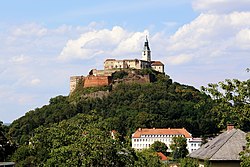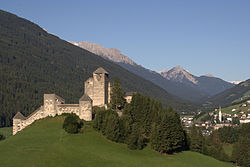You can help expand this article with text translated from the corresponding article in German. (July 2009)Click [show] for important translation instructions.
|
| Burgruine Hardegg | |
|---|---|
| Carinthia, Austria | |
 | |
| Site information | |
| Type | Castle |
| Location | |
 | |
| Coordinates | 46°43′02″N14°15′29″E / 46.7172222222°N 14.2580555556°E |
| Site history | |
| Built | before 1134 |
Burgruine Hardegg is a small Romanesque twin castle complex on a wooded hill north of the town of Zweikirchen in Carinthia, Austria. Nearby are the ruins of Liebenfels, Gradenegg and Liemberg, which, together with Hardegg, were among the main castles in the castle ring that surrounded the ducal capital of St. Veit.
Contents
The land on which the ruins are located is now privately owned by a farmer. Entering the ruins is prohibited due to the acute danger of collapse and the constantly loosening stones.












